Menu
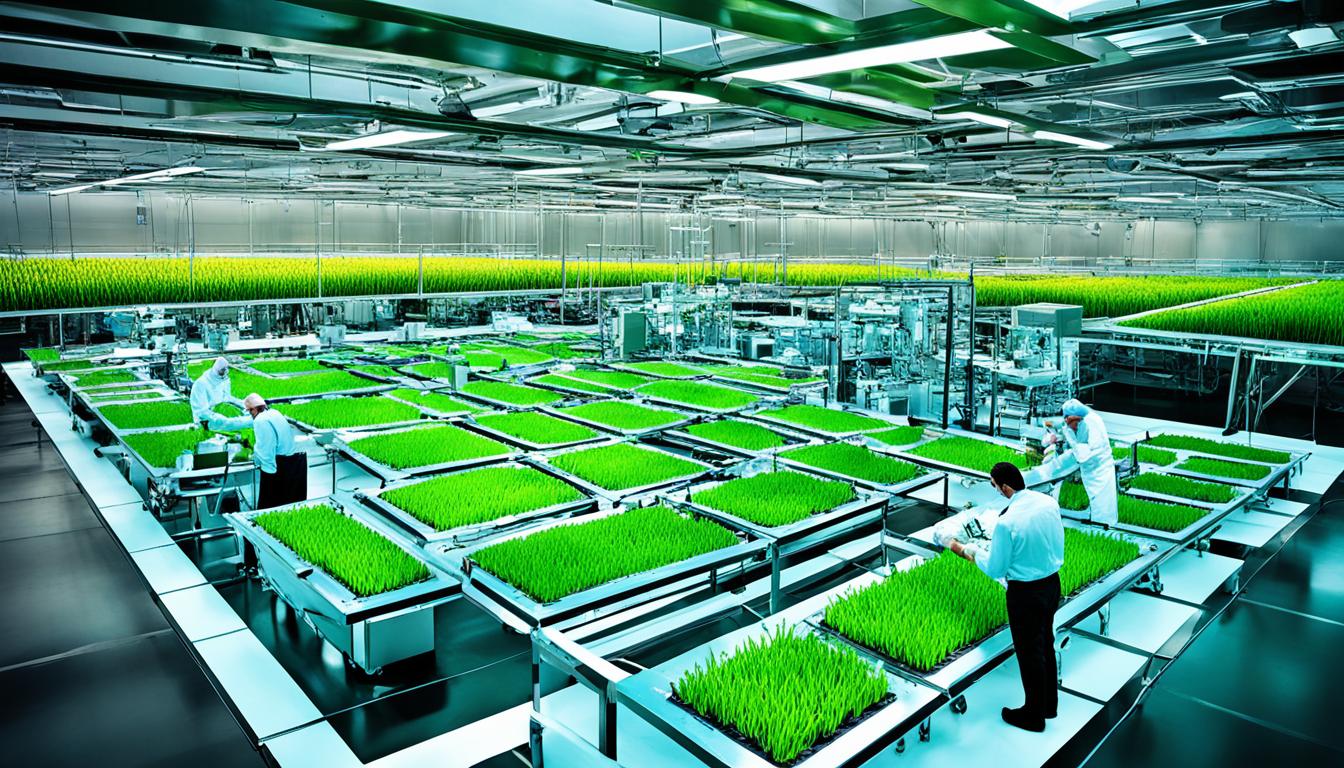
Did you know that top companies control the Agriculture Biotechnology market? Giants like Evogene Ltd., Syngenta AG, and DowDuPont Inc. lead the way. This market is ready to change how we do sustainable farming and make food.
The sector is at a key point, mixing science with a growing need for green practices. It offers ways to solve big issues like feeding more people and fighting climate change. Think about crops that fight off pests without heavy chemicals or lab-made meats. These breakthroughs are part of a push for a greener, healthier world for everyone.
In North America, they’re already big on using these biotech methods and researching more. On the other side, countries in the Asia-Pacific region are seeing how biotech can help make sure everyone has enough food. As the world gets ready for growing food in more sustainable ways, the role of biotech farming is more important than ever.
The biotech farming market is both complex and always changing. It covers crops like corn, soybeans, and cotton. These crops are mostly changed by genetic engineering. For example, in 2012, most of the U.S.’s corn, cotton, and soybeans were genetically modified.
Key to understanding this market is knowing about agricultural biotechnology trends. These trends are changing how we make food worldwide. They bring new methods like editing genomes and creating life from scratch. Thanks to these tools, we can make crops safe from insects, control weeds better, resist diseases, and even grow higher-quality plants.
Agricultural Biotechnology Trends and Their Impact
Data on the food we grow is very important, and the NASS in the U.S. checks it. They study crops that are changed by biotechnology. This data shows us if biotech farming is good for making more money and helping the environment. It also shows how it can make farming simpler.
Biotechnology keeps getting better, offering more each day. Scientists are working on many crops to use biotech ways even more. The ISAAA says much of the world’s farming land uses these modern ways. This shows how much farmers everywhere trust and use these new ideas.
Global Food Production and Regulatory Factors
The rules about these new ways are very important too. In the U.S., three big offices look at and approve biotech plants and products made from them. They make sure everything is safe and good for us. They also help farmers learn the best ways to use these new crops.
Biotech farming is getting more and more popular. Many groups, from food makers to schools, use this technology. They’re interested because it’s good for business, safe, and follows the rules. North America and Europe are very active, and Asia is quickly becoming a big player too.
“Agricultural biotechnology trends are undoubtedly steering the future of global food production, ensuring sustainability and efficiency throughout the food chain.”
Genetically modified crops are key for sustainable farming. They boost yields and quality. They also handle pests and harsh conditions better, improving food security.
These crops are made to resist bugs and tough weather. This means less need for harmful chemicals. It’s a big win for the planet and farmers.
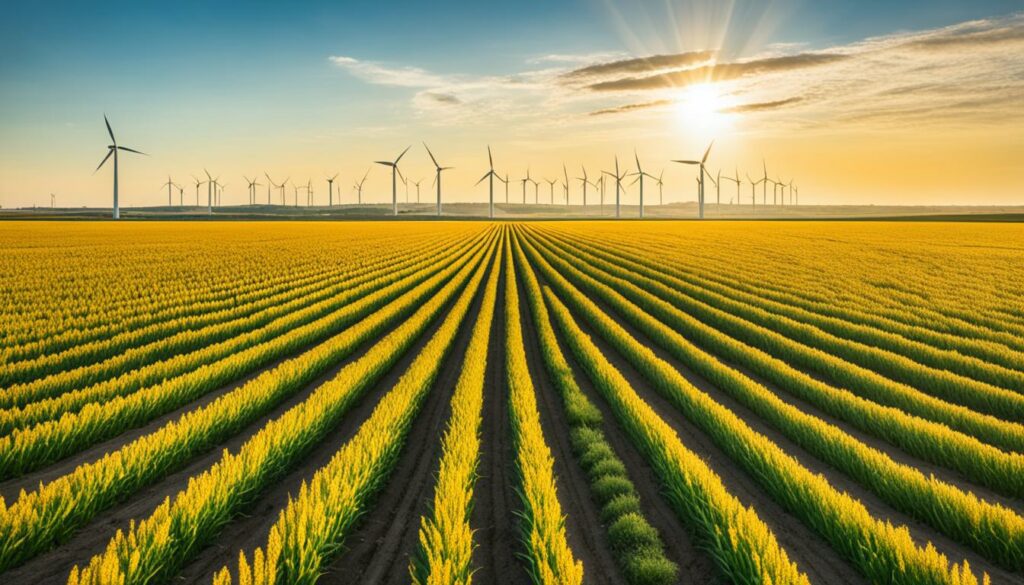
Genetically modified crops blend science with farming. Tools like CRISPR-Cas9 allow precise tweaks in a plant’s genes. This makes getting the desired traits much faster than before.
The practice of changing crop genes isn’t new. It’s evolved over thousands of years. Now, it’s way more advanced. The Flavr Savr tomato was the first in 1994. After that, this tech spread widely.
These crops significantly boost crop production. Studies from 1996 to 2012 show a huge leap in yields. This has helped feed more people, much like the green revolution in the past.
Genetically modified crops make food more nutritious and ensure there’s enough to go around. They help economies by cutting pesticide use and keeping soil healthy. This supports long-lasting farming methods.
| Crop | Modifications | Approved Year | Primary Benefits |
|---|---|---|---|
| Cotton | Herbicide resistance, pest resistance | 1996 | Reduced pesticide use |
| Corn | Herbicide resistance, disease resistance | 1996 | Increased productivity |
| Soybeans | Healthier oil production | 1997 | Enhanced nutritional content |
| Potatoes | Disease resistance | 1998 | Higher yields |
| Canola | Increased oil production | 1999 | Improved quality |
Precision farming combines efficiency and sustainability in agriculture perfectly. It uses the latest tech to aid decision-making and manage resources better. This makes farming smarter and more effective.
The market for precision farming will jump from USD 9.7 billion in 2023 to USD 21.9 billion by 2031. This quick growth is thanks to the use of advanced tools and data crunching. Key parts of this technology are GPS, GIS, drones, remote sensing, and IoT sensors. They help collect data that turns into useful advice for farmers.
Algorithms that use past data can predict how much crops will yield, decide when to water, and spot pests early. For instance, VRT lets farmers spread fertilisers differently across their fields to save resources. There is also farm software to make managing the farm easier, which boosts profits.
Farmers see big advantages from precision farming, like more crops, saving costs, and less harm to the planet. It tailors farming to what each crop needs. This makes farming greener and better for the future.
For the environment, precision farming cuts down on chemicals and lessens greenhouse gases. Using IoT devices with sensors, such as for soil moisture, saves water and makes crops healthier by checking things in real time. Putting seeds right in the soil with the help of tech means crops grow better and in a more even way.
Companies like Deere & Company, Trimble Inc., and AGCO Corporation are leading the way in biotechnologies for farming. They focus on creating new products, working closely with others, and teaching people more about farming tech. Thanks to these efforts, precision farming is creating a way to farm that’s good for the earth and efficient.
Agricultural biotechnology is changing farming’s future with new agricultural biotechnology innovations. Genome editing is one major innovation. It allows for exact changes in plants and animals, making them better.
CRISPR-Cas9 is at the heart of genome editing technologies. This tool has revolutionised how we study genetics and change crops. Now, we can give plants the power to fight diseases, survive without water, and be more nutritious. The use of CRISPR-Cas9 marks a big leap in making crops better and more efficient.
Livestock farming biotech applications also see big changes. CRISPR-Cas9 helps improve animals’ health and how much they produce. Harrisvaccines, started by Dr. Hank Harris, leads in this. They make vaccines for swine and poultry sicknesses. Their work includes creating the first pig vaccine for the H1N1 flu and saving 8 million piglet lives from the deadly porcine epidemic diarrhoea virus.
The work by companies like Harrisvaccines shows the huge impact of agricultural biotechnology innovations. They enhance farming from growing more crops to keeping animals healthier and productive. But, these changes need strong support to continue.
| Aspect | Detail |
|---|---|
| Genome Editing Technology | CRISPR-Cas9 |
| Biotech Vaccines | Harrisvaccines’ swine and poultry disease vaccines |
| Federal Funding Discrepancy | NIH R&D budget 16 times that of USDA in 2022 |
Even with how promising agricultural biotechnology innovations are, they still face challenges. There’s a major difference in funding, with the NIH getting much more than the USDA. This gap limits growth in agricultural research.
Knowing how each region’s market works is vital for studying biotech farming’s growth across the globe. Local investments, rules, and how quickly technology is taken up influence each place differently.

North America leads in biotech farming. It expects to hold over 35% of the market by 2026. This is thanks to significant efforts in research and development by top companies like Monsanto and DuPont Pioneer Hi-Bred.
These efforts help improve biotechnology in farming, which pushes the market forward.
In Europe, the scene is complex. Regulations are strict, ensuring high safety and protection standards for consumers. But these strict rules can slow down the use of biotech.
Europe, though, is set to have 25% of the market by 2026. It’s gradually accepting new technologies and is walking a path towards more innovative ways of farming.
The Asia-Pacific area is becoming the market to watch. It is expected to grow about 9% each year. Countries like China are using biotech to tackle food security using their own policies.
| Region | Projected Market Share by 2026 (%) | CAGR during Forecast Period (%) |
|---|---|---|
| North America | 35% | – |
| Europe | 25% | – |
| Asia-Pacific | – | 9% |
| Latin America | 15% | – |
| Middle East and Africa | 10% | – |
To sum up, grasping how regions differ helps us see the path of the biotech farming market. North America’s strong position and Europe’s changing rules are key in this complex global picture.
Food biotechnology is changing how we make food and meet global demand. It brings new, innovative products to the table. By July 2008, over 20 of these new products were already in markets.
Technologies like transgenic crops are changing farming worldwide. They’re making farming more efficient and reducing costs. For example, U.S. farmers saved $1.4 billion in 2005 thanks to biotech plants. These plants were able to resist chemicals and pests.
In India, biotech cotton that resists pests has improved farmer’s lives. It increased their yields by 29%, raising their incomes by 78%. These changes show how biotechnology can help farmers around the world.
Biotech crops are also helping the planet by lessening the use of fuel. They’ve saved 441 million gallons of it since 1996. This cut down carbon dioxide emissions, which is like taking off nearly four million cars from the road for a year.
These technological advances are not only boosting crop quality but also increasing yield. This is great news for farmers in developing countries. It helps them grow more food, which is very important as the world’s population grows.
People are starting to see food biotechnology in a more positive light too. A 2008 study showed that 53% of people were neither for nor against it. This middle ground suggests that public opinion is open to change, especially with more education about its benefits.
Livestock is also benefiting from these technologies. Processes like genome editing are making animals healthier and more productive. This is making the food supply chain stronger and more stable for the future.
Biotech farming boosts farmers’ incomes by enhancing profits. It does this through increased yields and saving money in agriculture. For example, in the U.S. in 2012, the adoption of biotech plantings was very high – around 88% for corn, 94% for cotton, and 93% for soybeans, according to the USDA’s NASS.
One big plus point of biotech farming is the promise of high returns on investment. Research, such as from ISAAA, shows the global use of biotech crops is vast. This leads to lower costs and more produce, which in turn, increases farmers’ earnings.
“From 1996 to 2007, the global impact of biotech crops resulted in substantial economic benefits, boosting farmer incomes by $44 billion,” elucidated Brookes G and Barfoot P in their study published in Agbioforum 2009.
Biotech crops are also very cost-effective. A study on the impacts of these crops in the U.S. in the mid-2000s found they saved money and boosted productivity. For instance, studies on Roundup Ready soybeans showed big improvements in how much was grown and the money made in places like Romania.
Economically and environmentally, glyphosate-tolerant soybeans in Ontario have made a big impact. A report for Monsanto Canada by the George Morris Centre in 2004 found big and long-lasting economic benefits. These benefits were in line with goals for broader sustainability.
The increase in profits due to biotech farming is very significant. The extra money from better yields and lower costs makes a strong argument for supporters. As the use of these technologies spreads, the possibility of more economic gains rises.
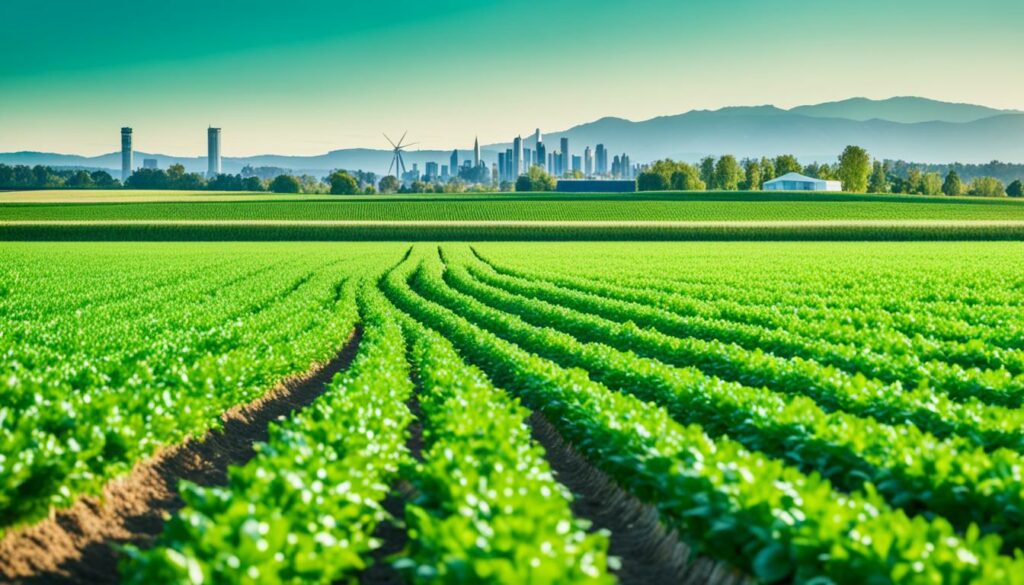
In today’s world, biotech farming challenges are really complex. We need to think about ethical issues and problems with sustainable farming. Each part needs careful thinking and review.
The Council of Europe Assembly highlighted ethical concerns in 2000. The UK’s Royal Society also stressed the importance of debate beyond just science in 2001.
Obstacles to sustainable agriculture were emphasized by the FAO in 2001. They said ethical values are key in agriculture, focusing on things like food security and health. John Paul II also underlined the need for ethical and scientific checks in 2000.
The Catholic Church’s 2004 document talked about being careful and responsible in biotech. In 2005, CAST suggested including ethics in agriculture as a solution to these challenges.
Having a balanced and open talk about biotech is crucial. This will help make advanced farming methods and our values work well together. It can also solve many controversies about biotech crops.
FAO outlined key actions in 2001 for everyone involved in food systems. This shows how important ethics are in making biotech work without causing fights.
| Year | Organisation | Recommendation/Highlight |
|---|---|---|
| 2000 | Council of Europe | Inclusion of ethical considerations in biotechnology. |
| 2001 | The United Kingdom’s Royal Society | Highlighted necessity for broader debate on GM food. |
| 2001 | FAO | Emphasised ethical values in agriculture. |
| 2004 | Pontifical Council for Justice and Peace | Stressed prudence and responsibility in biotechnology. |
| 2005 | CAST | Recommended institutionalising agricultural ethics. |
The future of crop breeding is changing fast with new tech and biotech research. These new methods are leading us into an agricultural revolution. They help us keep up with the growing need for food and challenges like climate change.
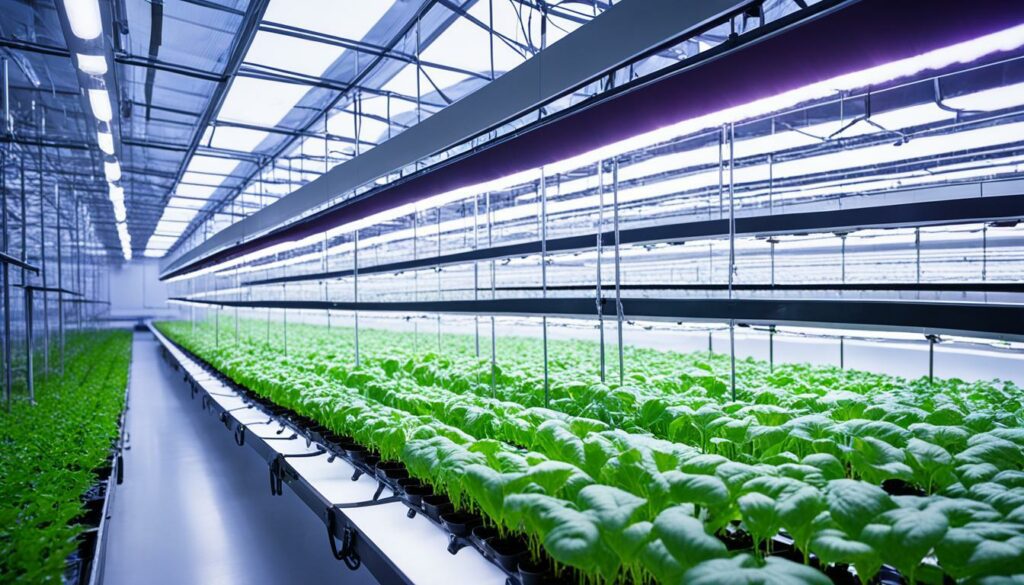
New breeding techniques, including using markers and advanced genetics, are shaping the future. Technologies like CRISPR allow accurate changes to make crops stronger against climate and pests.
In 2012, most corn, cotton, and soybeans in the U.S. were genetically modified. These stats show how widely GMOs and gene editing are used in crops.
Ongoing research is set to bring even more advancements to agriculture. The USDA keeps track of new biotech crop plantings to guide future studies. The goal is to create crops that grow well in tough conditions, increase yields, provide more nutrition, and resist diseases.
For example, virus-resistant papayas have saved the U.S. papaya industry. Such success stories point to the future of agriculture: focused on both sustainability and productivity.
Supporting agricultural biotechnology can lead to stronger, healthier crop types. It involves scientists, leaders in the field, and those who make agricultural policies. The key to future crop breeding is using the latest techniques and staying innovative. This move will make agriculture more stable and sustainable.
The biotech farming market offers many market opportunities. It is now a top choice for biotech farming investment trends. This sector has seen a lot of agricultural biotech funding. This money has led to new and exciting initiatives.
In 2023, Indigo Agriculture got $360 million in Series F funding. In 2022, Benson Hill picked up $150 million in Series D. Such big investments show the high hopes for tech in farming. They aim to change how we farm, tackling big issues like food security and the climate.
This money goes into areas like genetic editing. One outcome is non-browning mushrooms. Another is wheat and rice that resist diseases. We also see biopesticides from natural sources. They’re favoured for being safer and less harmful to the environment.
But, investors meet hurdles like market upsets and tough rules. They also have to cope with changes in technology. To tackle these, everyone needs to keep learning and come together. They must also watch out for new rules that might come up.
The field is tough, with big names including Bayer CropScience and Syngenta AG. Others like BASF SE are also leading. Governments help by offering money for research and a start-up boost. This keeps the biotech farming market moving ahead.
| Company | Funding Raised |
|---|---|
| Indigo Agriculture | $360 million (2023) |
| Benson Hill | $150 million (2022) |
Advancements in biotechnology don’t just boost farm yields. They also make crops stronger. They aim to up the nutrition in our food. Plus, they’re working to make farming less harmful to the planet. These steps are key in feeding the world and cutting down on farming’s negative effects.
The biotech farming market is largely impacted by key players and market collaborations. These guide the sector’s growth and innovation. Major players include Monsanto (now Bayer CropScience), Syngenta AG, and others. Companies like Bioceres Crop Solutions and KWS SAAT SE are also critical in leading biotech innovation.
Partnerships between these large and small firms are important. They help advance technology, improve products, and grow their markets. These ties are vital in making the industry more competitive and forward-thinking.
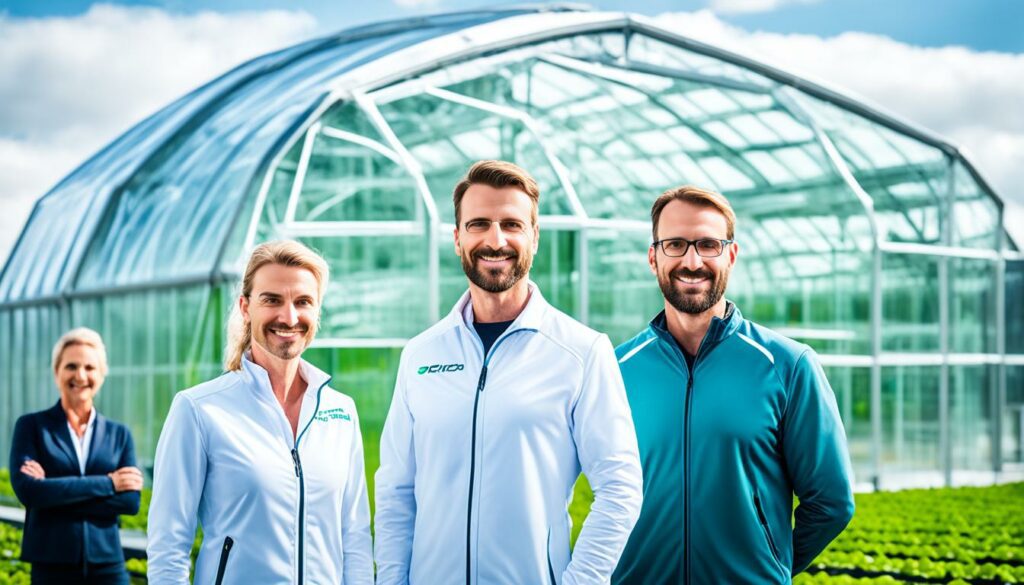
Key players in agricultural biotechnology, such as Monsanto Company and BASF SE, lead innovation. They prove the value of working together through joint ventures. These focus on genetic engineering and crop improvement.
These collaborations also influence emerging markets. Regions like North America and Asia are key for the Agricultural Biotechnology Market’s growth. The partnerships promote strong research and product development. This leads to innovative uses in crop and animal health.
| Company | Focus Area | Region |
|---|---|---|
| Monsanto (Bayer CropScience) | Genetic Engineering, Crop Improvement | North America, Europe |
| Syngenta AG | Pest Resistance, Molecular Breeding | Global |
| DowDuPont Inc. | Biotechnological Solutions | North America, Asia Pacific |
| BASF SE | Advanced Genomic Technologies | Global |
| Bayer AG | Sustainable Agriculture Methods | Europe, North America |
| Bioceres Crop Solutions Corp. | Transgenic Crops | Latin America |
| Evogene Ltd. | Crop Yield Enhancement | Global |
| KWS SAAT SE | Molecular Marker-Assisted Breeding | Europe |
| Limagrain | Hybrid Seeds | Europe |
| ADAMA Ltd. | Crop Protection, Seed Traits | Asia Pacific |
Successful market collaborations create a space where top players work together towards common goals. This pushes the biotech farming sector towards a bright and sustainable future.
Government rules and support are key in shaping the biotech farming market. They’re mainly about helping use high-yield crops made through biotechnology. In the US, for example, most of their corn, cotton, and soybeans in 2012 were genetically engineered. This shows how strong government rules can help the market grow.
In North America, governments have made things good for growing and selling biotech crops. They give out money, have easy rules to follow, and help farmers grow different crops together. The United States Department of Agriculture made a group to look at different farming ways. This group helps everyone get along and grow biotech crops safely.
Laws are really important for making new things, making sure they’re safe, and everyone follows the rules. The USDA made rules for checking new biotech stuff in 1986, which made the market strong. The USDA, EPA, and FDA are in charge of making sure these new things are safe and won’t hurt the environment or people.
These rules and government help have made big changes in the farming world. They’ve made it easy for farmers worldwide to grow high-tech crops. Now, many of these crops are out there, changing how people farm and making a big mark on the world market.
Grasping how consumers view biotech farming is complex due to varied opinions. It’s key to look at the benefits, risks, and efforts to educate and keep things clear.

Many highlight the good in biotech farming: more crops, less pesticide, and eco-friendliness. This is clear in Table 4.1: Response Rate of Survey Participants. Yet, worries over the environment and GM health effects are big concerns.
| Perceived Benefits | Percentage of Respondents |
|---|---|
| Increased Crop Yields | 75% |
| Reduced Pesticide Use | 68% |
| Enhanced Sustainability | 54% |
| Perceived Risks | Percentage of Respondents |
| Environmental Repercussions | 65% |
| Health Concerns | 52% |
Education in biotech is vital. Making the biotech market clear helps consumers be informed. Look at Table 4.3: Awareness Levels of Biotechnology. It shows we need better ways to talk about the science and safety of biotech. This can lower worries and increase trust.
| Awareness Level | Percentage of Respondents |
|---|---|
| High | 40% |
| Moderate | 35% |
| Low | 25% |
Also, being open about products and how they are marked is crucial. Evidence from Table 4.6: Preference for Mandatory versus Voluntary Labeling Policy and Table 4.7: Percentage of Respondents Indicating Their Use of Food Labels shows good info affects consumer choices a lot.
The biotech farming market is always changing. We see new trends that show how much this sector is growing. A big trend now is using CRISPR and other gene-editing methods more. These techniques improve crops by making them have better yields and resist pests.
*Agricultural biotech market growth* also comes from using synthetic biology more. This leads to crops that are better for us and that grow more. And, we’re getting ready for farming in the future with better technologies.
Using data and AI for farming is becoming more common. These tools make farming smarter and more sustainable. They help use resources better and improve how we make decisions.
In North America, these farming innovations are growing fast. They are leading in market share and investing a lot in research. The prediction is that bio-fertilizers and genetic engineering will keep growing until 2031.
In 2024, we’re likely to see big changes in biotech farming. RNA and CRISPR will be used more in treating diseases. To keep up, people in the industry need to watch these trends closely.
The future of biotech farming looks very promising. With these new trends, farming will be more efficient and better for the environment. Those who follow these trends will be ready for the future of farming.
Our journey into the biotech farming market shows just how important it is for our future. Mixing new science with how we care for the Earth is vital for feeding the world safely. Progress in making plants and animals healthier is pointing towards a bright future.
This market is on the rise, from $38,918.85 Million in 2022 to a predicted $66,646.82 Million by 2028. Big names like DuPont Pioneer Hi-Bred, Syngenta, and Bayer are leading. They use exciting technologies to make farming both better and greener. Helping countries with less money join in is key to spreading the benefits wide.
The future holds a promise of greener farming and ways to cope with a changing climate. Working together is key. Governments, companies, and local farmers need to team up. Making sure people know and trust these new ways is also vital. The biotech farming market offers not just quick fixes, but a solid and Earth-friendly future for all.
The biotech farming market uses biotechnology in agriculture. It improves crops and animals for better food and protection against diseases, and harsh weather. It helps make more food and deal with climate change and hunger worldwide.
Genetically modified crops withstand pests and tough climates. They contain better nutrients and need fewer pesticides. This makes farming more sustainable, uses fewer chemicals, and helps ensure there’s enough food for everyone.
Precision farming uses tools like biotechnology, data analysis, GPS, and sensors. These help farmers manage their fields better. It means making smarter decisions, using resources wisely, and protecting the environment.
Genome editing, like CRISPR-Cas9, changes DNA in specific ways. This lets us make plants and animals that are healthier or more productive. It’s a big step in making agriculture more advanced.
North America is at the forefront, investing heavily in biotechnology for farming. Europe is overcoming its rules to catch up in biotech. The Asia-Pacific region, particularly China, is also becoming a major player by using this tech for food security.
Food biotechnology changes how food is made and used worldwide. It involves making food with new methods, which meets growing demands. These methods also help protect our planet and make markets work better.
Biotech farming boosts yields, saves money, and increases farmers’ profits. It creates jobs in tech and research, and gives good returns to those investing in farming. It’s a key player in the economy.
Biotech farming faces pushback due to concerns over genetic changes, synthetic biology, and effects on the environment. There are ethical debates on the long-term effects and how to have fair discussions. Dialogues aim to get people to accept these technologies.
In the future, we aim to create crops with new tools, able to survive tough climates and fight pests. This requires ongoing investment in new techniques and research. The goal is to grow crops that are strong and nutritious.
The biotech farming market is growing, offering chances for investment. Both governments and private sectors fund genetic crop changes, new farming methods, and crops food-rich. This is leading to groundbreaking developments in agriculture.
Multinational companies like Monsanto and BASF, along with smaller biotech companies and research bodies, play a major role. Their teamwork drives progress, innovation, and market growth.
Government policies set rules for safe and innovative farming. Support in the form of money, laws, and help in major markets like North America and the Asia-Pacific is encouraging. It helps growing and selling new biotech crops.
Consumers feel both positive and worried about biotech farming. They see benefits in more food and eco-friendly farming. But, they are concerned about genetic changes and effect on the environment. Clear education and information are key to winning them over.
Trends show an increase in using CRISPR and other editing methods, and in synthetic biology. Precision farming with data tools is also growing. Plus, there’s more focus on crops that are better for us and the environment.